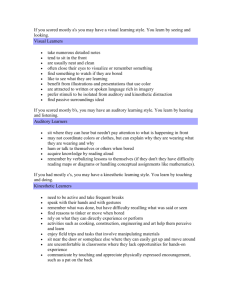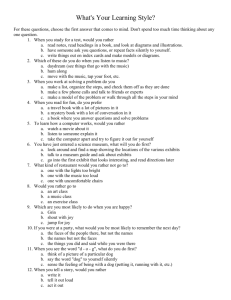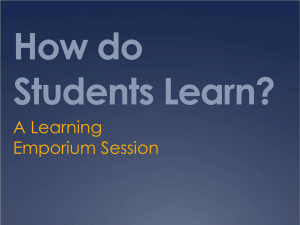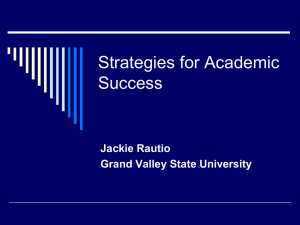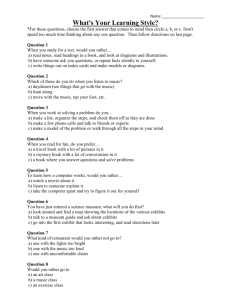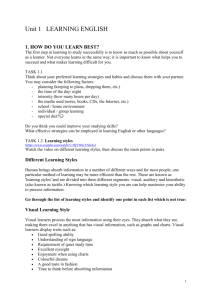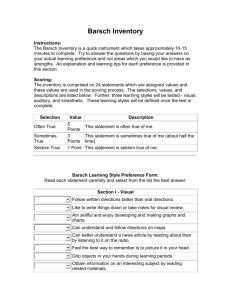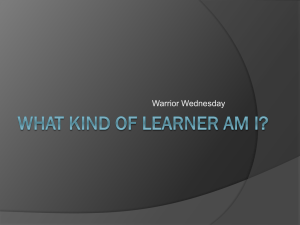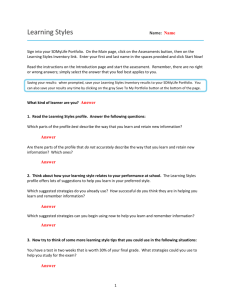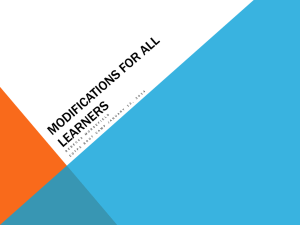STUDENT ADVISORY ACTIVITY - Waterbury Public Schools
advertisement
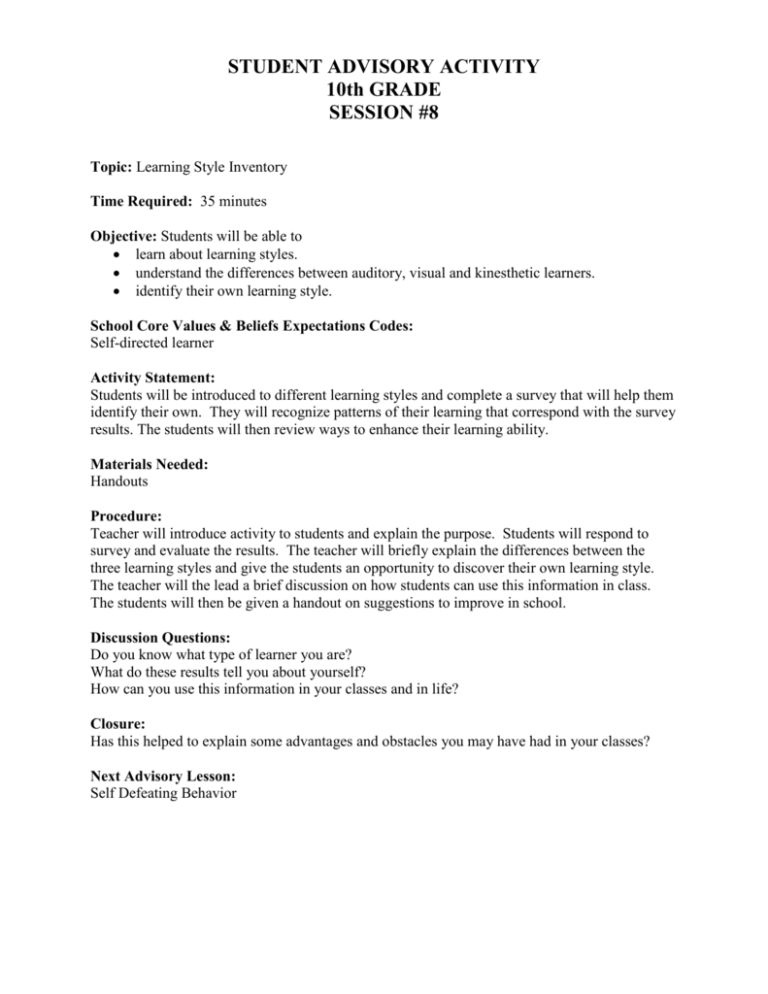
STUDENT ADVISORY ACTIVITY 10th GRADE SESSION #8 Topic: Learning Style Inventory Time Required: 35 minutes Objective: Students will be able to learn about learning styles. understand the differences between auditory, visual and kinesthetic learners. identify their own learning style. School Core Values & Beliefs Expectations Codes: Self-directed learner Activity Statement: Students will be introduced to different learning styles and complete a survey that will help them identify their own. They will recognize patterns of their learning that correspond with the survey results. The students will then review ways to enhance their learning ability. Materials Needed: Handouts Procedure: Teacher will introduce activity to students and explain the purpose. Students will respond to survey and evaluate the results. The teacher will briefly explain the differences between the three learning styles and give the students an opportunity to discover their own learning style. The teacher will the lead a brief discussion on how students can use this information in class. The students will then be given a handout on suggestions to improve in school. Discussion Questions: Do you know what type of learner you are? What do these results tell you about yourself? How can you use this information in your classes and in life? Closure: Has this helped to explain some advantages and obstacles you may have had in your classes? Next Advisory Lesson: Self Defeating Behavior What's YOUR Learning Style? Purpose: To learn about learning styles. To understand the differences between auditory, visual and kinesthetic learners To identify your own learning style There are three basic types of learning styles. The three most common are visual, auditory, and kinesthetic. To learn, we depend on our senses to process the information around us. Most people tend to use one of their senses more than the others. Today's lesson will help you determine which of these learning styles you rely on the most. There is a series of 16 questions that are related to the three main learning styles. Read the question and select the answer that closest fits your answer. Don't think about the questions too much. Go with your first choice. After you answer each of these questions, go backand count the number of A’s, B’s and C’s. The letter that you circled most frequently will reflect your primary learning style, more A's means Visual , more B's means Auditory and more C's means Kinesthetic.. Some people depend on two or more types of learning styles. It is not unusual to use different learning styles for different tasks. That's why people can respond so differently to the same thing. What's Your Learning Style For these questions, choose the first answer that comes to mind and circle a,b, or c. Don't spend too much time thinking about any one question. Question 1 When you study for a test, would you rather a) read notes, read headings in a book, and look at diagrams and illustrations. b) have someone ask you questions, or repeat facts silently to yourself. c) write things out on index cards and make models or diagrams. Question 2 Which of these do you do when you listen to music? a) daydream (see things that go with the music) b) hum along c) move with the music, tap your foot, etc. Question 3 When you work at solving a problem do you a) make a list, organize the steps, and check them off as they are done b) make a few phone calls and talk to friends or experts c) make a model of the problem or walk through all the steps in your mind Question 4 When you read for fun, do you prefer a) a travel book with a lot of pictures in it b) a mystery book with a lot of conversation in it c) a book where you answer questions and solve problems Question 5 To learn how a computer works, would you rather a) watch a movie about it b) listen to someone explain it c) take the computer apart and try to figure it out for yourself Question 6 You have just entered a science museum, what will you do first? a) look around and find a map showing the locations of the various exhibits b) talk to a museum guide and ask about exhibits c) go into the first exhibit that looks interesting, and read directions later Question 7 What kind of restaurant would you rather not go to? a) one with the lights too bright b) one with the music too loud c) one with uncomfortable chairs Question 8 Would you rather go to a) an art class b) a music class c) an exercise class Question 9 Which are you most likely to do when you are happy? a) grin b) shout with joy c) jump for joy Question 10 If you were at a party, what would you be most likely to remember the next day? a) the faces of the people there, but not the names b) the names but not the faces c) the things you did and said while you were there Question 11 When you see the word "d - o - g", what do you do first? a) think of a picture of a particular dog b) say the word "dog" to yourself silently c) sense the feeling of being with a dog (petting it, running with it, etc.) Question 12 When you tell a story, would you rather a) write it b) tell it out loud c) act it out Question 13 What is most distracting for you when you are trying to concentrate? a) visual distractions b) noises c) other sensations like, hunger, tight shoes, or worry Question 14 What are you most likely to do when you are angry? a) scowl b) shout or "blow up" c) stomp off and slam doors Question 15 When you aren't sure how to spell a word, which of these are you most likely to do? a) write it out to see if it looks right b) sound it out c) write it out to see if it feels right Question 16 Which are you most likely to do when standing in a long line at the movies? a) look at posters advertising other movies b) talk to the person next to you c) tap your foot or move around in some other way After completing the survey, count up the number of A’s, B’s and C’s you have circled. Look at the numbers - more A's means Visual , more B's means Auditory and more C's means Kinesthetic. Three Different Learning Styles If you scored mostly a's you may have a visual learning style. You learn by seeing and looking. Visual Learners take numerous detailed notes tend to sit in the front are usually neat and clean often close their eyes to visualize or remember something find something to watch if they are bored like to see what they are learning benefit from illustrations and presentations that use color are attracted to written or spoken language rich in imagery prefer stimuli to be isolated from auditory and kinesthetic distraction find passive surroundings ideal If you scored mostly b's, you may have an auditory learning style. You learn by hearing and listening. Auditory Learners sit where they can hear but needn't pay attention to what is happening in front may not coordinate colors or clothes, but can explain why they are wearing what they are wearing and why hum or talk to themselves or others when bored acquire knowledge by reading aloud remember by verbalizing lessons to themselves (if they don't they have difficulty reading maps or diagrams or handling conceptual assignments like mathematics). If you had mostly c's, you may have a kinesthetic learning style. You learn by touching and doing. Kinesthetic Learners need to be active and take frequent breaks speak with their hands and with gestures remember what was done, but have difficulty recalling what was said or seen find reasons to tinker or move when bored rely on what they can directly experience or perform activities such as cooking, construction, engineering and art help them perceive and learn enjoy field trips and tasks that involve manipulating materials sit near the door or someplace else where they can easily get up and move around are uncomfortable in classrooms where they lack opportunities for hands-on experience communicate by touching and appreciate physically expressed encouragement, such as a pat on the back Discussion Suggestions: How could knowing your learning style be of benefit to you, personally? How can it be helpful in your interactions with others? How do you think this could help you in your studies? How do you think this could help you in lectures? How do you think this could help you in note taking? Here are some more practical suggestions pertaining to each learning style: Visual Learners: use visual materials such as pictures, charts, maps, graphs, etc. have a clear view of your teachers when they are speaking so you can see their body language and facial expression use colour to highlight important points in text take notes or ask your teacher to provide handouts illustrate your ideas as a picture or brainstorming bubble before writing them down write a story and illustrate it use multi-media (e.g. computers, videos, and filmstrips) study in a quiet place away from verbal disturbances read illustrated books visualize information as a picture to aid memorization Auditory Learners: participate in class discussions/debates make speeches and presentations use a tape recorder during lectures instead of taking notes read text out aloud create musical jingles to aid memorization create mnemonics to aid memorization discuss your ideas verbally dictate to someone while they write down your thoughts use verbal analogies, and story telling to demonstrate your point Tactile/Kinesthetic Learners take frequent study breaks move around to learn new things (e.g. read while on an exercise bike, mold a piece of clay to learn a new concept) work at a standing position chew gum while studying use bright colors to highlight reading material dress up your work space with posters if you wish, listen to music while you study skim through reading material to get a rough idea what it is about before settling down to read it in detail.
